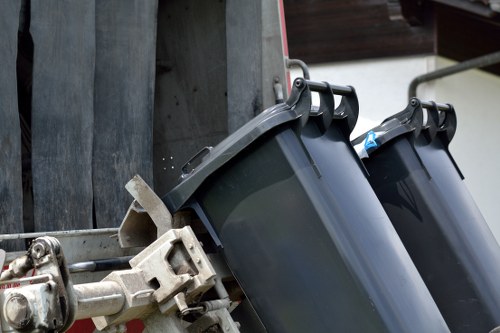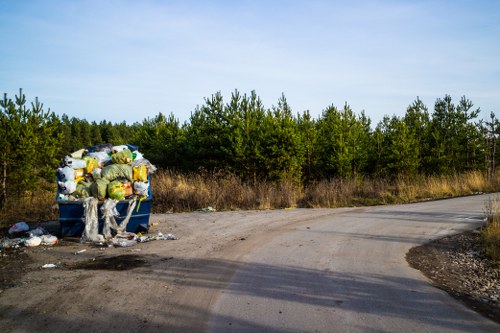Comprehensive Guide to Site Clearance in Bayswater

Site clearance is a critical first step in any construction or renovation project in Bayswater. It involves the removal of unwanted materials, debris, and vegetation to prepare the land for development. Whether you're planning a new build, landscaping, or simply decluttering your property, professional site clearance services can make the process efficient and stress-free.
Choosing the right site clearance service ensures that the job is done safely, legally, and with minimal disruption to your daily life. Bayswater, being a bustling suburb, requires specialized knowledge of local regulations and environmental considerations. This guide will walk you through the essentials of site clearance in Bayswater, helping you make informed decisions for your project.
In this comprehensive overview, we'll cover the various aspects of site clearance, including the types of services available, the benefits of hiring professionals, and the steps involved in the process. Whether you're a homeowner, builder, or landscaper, understanding site clearance is essential for a successful project.

What is Site Clearance?
Site clearance refers to the process of removing obstacles or unwanted materials from a construction site. This can include clearing land, removing vegetation, demolishing existing structures, and hauling away debris. The goal is to prepare the site for new development by ensuring it is clean, safe, and ready for the next phase of the project.
In Bayswater, site clearance may also involve dealing with specific challenges such as heritage-listed sites, environmental protections, and local council regulations. Professional site clearance services are well-versed in these requirements, ensuring compliance and avoiding potential legal issues.
Effective site clearance not only makes the construction process smoother but also contributes to the overall success and sustainability of the project. By removing hazards and preparing the land properly, you set the stage for efficient construction and long-term stability.

Types of Site Clearance Services
Land Clearing
Land clearing involves removing trees, shrubs, and other vegetation to prepare the land for construction or landscaping. This service is essential for creating a clean slate, especially in areas with dense foliage.
Debris Removal
Debris removal focuses on hauling away construction waste, old materials, and any other unwanted items from the site. This helps maintain a tidy workspace and prevents potential safety hazards.
Structural Demolition
Structural demolition is the process of tearing down existing buildings or structures that are no longer needed or are being replaced. This requires careful planning to ensure safety and minimize environmental impact.

Benefits of Professional Site Clearance
Efficiency and Expertise
Professional site clearance teams bring expertise and experience to the table, ensuring that the job is done correctly and efficiently. They have the necessary equipment and knowledge to tackle even the most challenging projects.
Compliance with Regulations
Hiring professionals ensures that all local regulations and environmental guidelines are followed. This prevents legal complications and promotes responsible land use.
Safety
Site clearance can be hazardous, involving heavy machinery and potential risks. Professionals adhere to safety protocols to protect both themselves and the property.

Steps Involved in Site Clearance
Assessment and Planning
The first step in site clearance is assessing the site and developing a clear plan of action. This involves identifying the scope of work, potential challenges, and necessary resources.
Permits and Approvals
Securing the necessary permits and approvals from local authorities is crucial. Professional site clearance services handle this process, ensuring all legal requirements are met.
Execution
The actual clearance involves removing vegetation, demolishing structures, and hauling away debris. This phase requires coordination and the use of appropriate machinery to ensure efficiency.
Final Inspection
After clearance, a final inspection ensures that the site is ready for the next phase of the project. This step verifies that all tasks have been completed to the required standards.
Environmental Considerations
Site clearance can have significant environmental impacts, especially in areas like Bayswater with diverse ecosystems. It's essential to adopt sustainable practices to minimize harm.
Preservation of Native Flora and Fauna
Whenever possible, efforts should be made to preserve native plants and wildlife. This includes careful removal of vegetation and avoiding disruption to local habitats.
Proper Waste Management
Implementing effective waste management strategies ensures that materials are disposed of responsibly. Recycling and reusing materials can reduce the environmental footprint of site clearance activities.
Choosing the Right Site Clearance Service in Bayswater
- Experience and Reputation: Look for companies with a proven track record and positive reviews.
- Licensing and Insurance: Ensure that the service provider is properly licensed and insured to cover any potential damages.
- Comprehensive Services: Choose a company that offers a full range of site clearance services to meet all your project needs.
- Transparent Pricing: Clear and upfront pricing helps avoid unexpected costs.
It's also beneficial to request quotes and consult with multiple providers to find the best fit for your specific requirements.
Engaging with a professional site clearance service in Bayswater not only ensures quality work but also provides peace of mind knowing that your project is in capable hands.
Cost Factors in Site Clearance
The cost of site clearance in Bayswater can vary based on several factors:
- Size of the Site: Larger areas require more time and resources, increasing costs.
- Type of Clearance: Specialized services like structural demolition may incur higher fees.
- Accessibility: Sites that are hard to reach or have difficult terrain may require additional equipment or labor.
- Waste Disposal: Costs related to hauling and disposing of debris can vary depending on the volume and type of materials.
Obtaining a detailed quote from your chosen service provider can help you understand the specific costs involved and plan your budget accordingly.
Safety Measures in Site Clearance
Safety is paramount in site clearance operations. Professional services adhere to strict safety protocols to protect workers, clients, and the surrounding environment.
Key safety measures include:
- Use of Personal Protective Equipment (PPE)
- Regular equipment maintenance and inspections
- Proper training for all personnel
- Compliance with local safety regulations
By prioritizing safety, site clearance services ensure that projects proceed without incidents, maintaining a secure and efficient work environment.
Common Challenges in Site Clearance
Site clearance projects can encounter various challenges, especially in urban areas like Bayswater:
- Restricted Access: Limited space or difficult terrain can complicate clearance efforts.
- Hidden Hazards: Underground utilities or contaminated materials may require specialized handling.
- Environmental Regulations: Adhering to stringent environmental laws necessitates careful planning and execution.
- Time Constraints: Tight project deadlines demand efficient and effective clearance solutions.
Addressing these challenges requires experienced professionals who can navigate complexities and deliver results on time.
The Importance of Timely Site Clearance
Timely site clearance is essential for staying on schedule and avoiding costly delays. Delays in the clearance phase can have a ripple effect, impacting subsequent stages of the project.
Effective time management ensures that construction or development progresses smoothly, maintaining momentum and reducing the risk of budget overruns.
Professional site clearance services in Bayswater understand the importance of deadlines and work diligently to meet your project's timeline.
Sustainable Site Clearance Practices
Incorporating sustainable practices in site clearance not only protects the environment but also enhances the reputation of your project.
Recycling Materials:
Recycling wood, metal, and other materials reduces waste and promotes sustainable resource management.
Erosion Control:
Implementing erosion control measures prevents soil degradation and maintains the integrity of the site.
Minimizing Carbon Footprint:
Using energy-efficient machinery and optimizing logistics can significantly reduce the carbon footprint of site clearance activities.
Legal Considerations in Site Clearance
Compliance with local laws and regulations is crucial in site clearance projects. Non-compliance can lead to fines, legal disputes, and project delays.
Key legal considerations include:
- Permitting: Obtaining necessary permits from local authorities before commencing work.
- Environmental Laws: Adhering to regulations related to protected species, tree removal, and waste disposal.
- Health and Safety Standards: Ensuring that all activities comply with occupational health and safety laws.
- Zoning Laws: Understanding and adhering to zoning restrictions that may affect site clearance and subsequent development.
Working with a knowledgeable site clearance service can help navigate these legalities, ensuring that your project remains compliant and free from legal issues.
The Role of Technology in Site Clearance
Advancements in technology have revolutionized site clearance, making the process more efficient and environmentally friendly.
Heavy Machinery:
Modern machinery increases the speed and accuracy of clearance tasks, handling large volumes of material with ease.
Software and Planning Tools:
Digital tools aid in project planning, tracking progress, and managing resources effectively.
Eco-friendly Equipment:
Electric and hybrid machinery reduces emissions, contributing to sustainable clearance operations.
Case Studies: Successful Site Clearance in Bayswater
Residential Development: A local builder in Bayswater utilized professional site clearance services to prepare a challenging urban site. The team efficiently removed old structures and vegetation, allowing the project to commence on schedule.
Commercial Project: A commercial complex required extensive site clearance, including debris removal and land leveling. The clearance team managed the project seamlessly, meeting all environmental and safety standards.
Landscaping Enhancement: A homeowner sought to transform their backyard in Bayswater. Site clearance services removed unwanted trees and waste, laying the groundwork for a beautiful new landscape design.
Future Trends in Site Clearance
The field of site clearance is continually evolving, with several trends shaping its future:
- Increased Automation: Robotics and automated machinery are set to enhance efficiency and reduce labor costs.
- Green Clearance Practices: Greater emphasis on sustainability and eco-friendly methods.
- Data-Driven Planning: Utilizing big data and analytics for more precise and effective clearance strategies.
- Integrated Services: Offering comprehensive solutions that combine clearance with other construction services.
Staying abreast of these trends ensures that site clearance services remain effective, sustainable, and aligned with industry advancements.
Conclusion
Site clearance is a foundational aspect of any development project in Bayswater. Investing in professional services not only ensures that the job is done efficiently and safely but also aligns with legal and environmental standards. By understanding the intricacies of site clearance, from planning and execution to sustainability and future trends, you can make informed decisions that contribute to the success of your project.
Don’t let the complexities of site clearance hinder your project’s progress. Contact us today to learn more about our comprehensive site clearance services and take the first step towards a successful development.